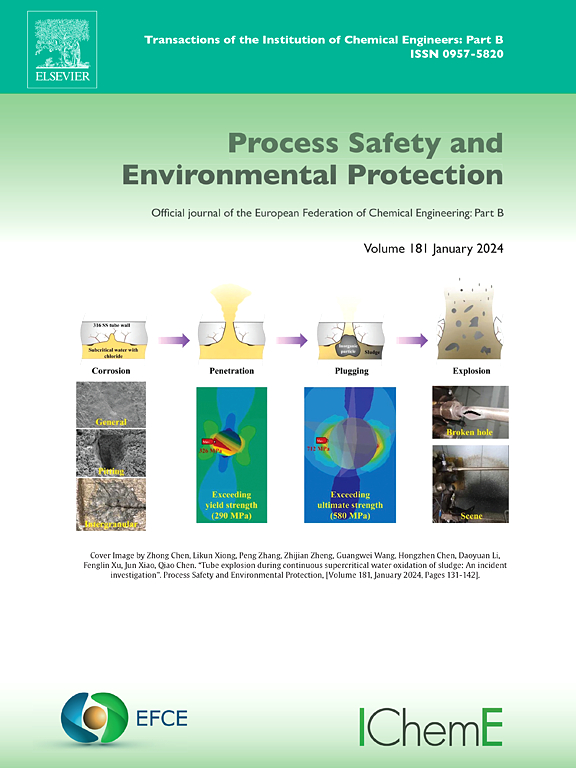Synergistic bio-adsorption and methane production using plant residues for enhanced heavy metal removal and anaerobic digestion efficiency
IF 6.9
2区 环境科学与生态学
Q1 ENGINEERING, CHEMICAL
引用次数: 0
Abstract
Tackling the dual challenge of environmental contamination and renewable energy demands, this study explores the potential of plant residues in wastewater treatment. Watermelon plant residue (WPR), eggplant plant residue (EPR), and their combination (WPR + EPR) were evaluated as eco-friendly bio-adsorbents for heavy metal removal while enhancing anaerobic digestion. The WPR + EPR combination achieved the highest removal efficiencies for Zinc (Zn) (98.37 %), copper (Cu) (92.87 %), lead (Pb) (73.86 %), and iron (Fe) (69.42 %). Individually, WPR was most effective for cobalt (Co) (95.19 %), nickel (Ni) (94.86 %), and manganese (Mn) (94.23 %), while EPR excelled in chromium (Cr) removal (92.41 %). Synergistic effects in the combined treatment resulted in the highest cumulative adsorption capacity (0.18932 mg/g), leveraging complementary functional groups. Adsorption followed chemisorption-dominated pseudo-second-order kinetics, with rapid phases described by the Elovich model and intra-particle diffusion contributing at later stages, particularly for Ni and Mn. Bio-adsorption enhanced anaerobic digestion, with WPR producing the most biogas (288.3 mL) and the highest chemical oxygen demand (COD) removal (53.16 %). Principal Component Analysis identified WPR post-adsorption as the most effective. This study demonstrates the dual advantages of bio-adsorption in wastewater treatment and bioenergy recovery, emphasizing agricultural residues as sustainable and cost-effective solutions.
协同生物吸附和甲烷生产利用植物残留物提高重金属去除和厌氧消化效率
为了解决环境污染和可再生能源需求的双重挑战,本研究探讨了植物残留物在废水处理中的潜力。研究了西瓜植物渣(WPR)、茄子植物渣(EPR)及其组合(WPR + EPR)在促进厌氧消化的同时去除重金属的环保型生物吸附剂。WPR + EPR组合对锌(Zn)(98.37 %)、铜(Cu)(92.87 %)、铅(Pb)(73.86 %)和铁(Fe)(69.42 %)的去除率最高。其中,WPR对钴(Co)(95.19 %)、镍(Ni)(94.86 %)和锰(Mn)(94.23 %)的去除率最高,EPR对铬(Cr)的去除率最高(92.41 %)。在联合处理中,利用互补的官能团,协同效应导致累积吸附量最高(0.18932 mg/g)。吸附遵循化学吸附为主的伪二级动力学,Elovich模型描述的快速相和颗粒内扩散在后期阶段起作用,特别是Ni和Mn。生物吸附增强厌氧消化,WPR产气量最高(288.3 mL),化学需氧量(COD)去除率最高(53.16 %)。主成分分析表明WPR后吸附效果最好。该研究展示了生物吸附在废水处理和生物能源回收中的双重优势,强调了农业残留物是可持续的和具有成本效益的解决方案。
本文章由计算机程序翻译,如有差异,请以英文原文为准。
求助全文
约1分钟内获得全文
求助全文
来源期刊

Process Safety and Environmental Protection
环境科学-工程:化工
CiteScore
11.40
自引率
15.40%
发文量
929
审稿时长
8.0 months
期刊介绍:
The Process Safety and Environmental Protection (PSEP) journal is a leading international publication that focuses on the publication of high-quality, original research papers in the field of engineering, specifically those related to the safety of industrial processes and environmental protection. The journal encourages submissions that present new developments in safety and environmental aspects, particularly those that show how research findings can be applied in process engineering design and practice.
PSEP is particularly interested in research that brings fresh perspectives to established engineering principles, identifies unsolved problems, or suggests directions for future research. The journal also values contributions that push the boundaries of traditional engineering and welcomes multidisciplinary papers.
PSEP's articles are abstracted and indexed by a range of databases and services, which helps to ensure that the journal's research is accessible and recognized in the academic and professional communities. These databases include ANTE, Chemical Abstracts, Chemical Hazards in Industry, Current Contents, Elsevier Engineering Information database, Pascal Francis, Web of Science, Scopus, Engineering Information Database EnCompass LIT (Elsevier), and INSPEC. This wide coverage facilitates the dissemination of the journal's content to a global audience interested in process safety and environmental engineering.
 求助内容:
求助内容: 应助结果提醒方式:
应助结果提醒方式:


